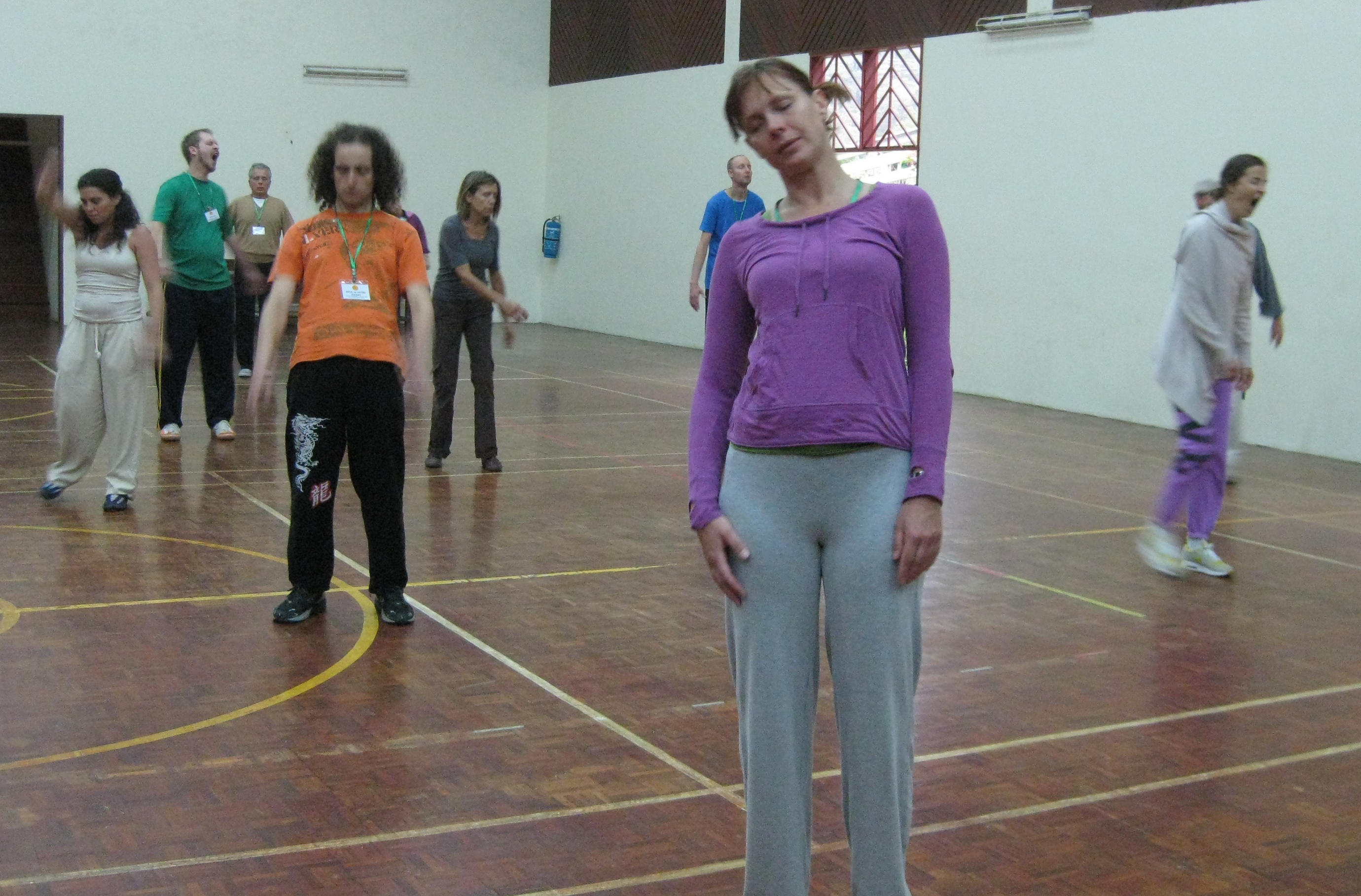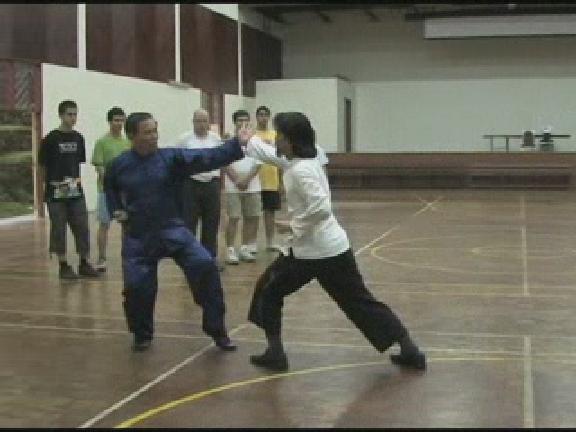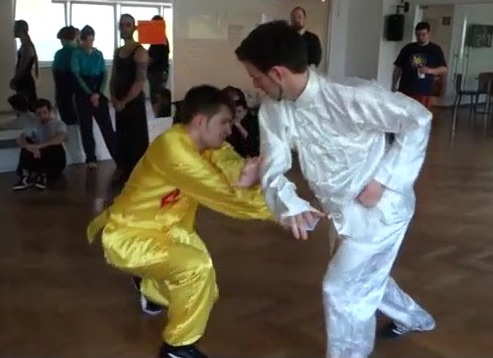BUILDING FOUNDATIONS OF BASIC SKILLS

Being relaxed, freeing the mind of irrelevant thoughts and generating an energy flow are basic sklls in chi kung
Question
So much advanced material now available to even beginning students at regional courses, etc. it is easy to neglect the basics. Like any great development, a solid basis is required for our training. How should students (of all levels) ensure that the foundations are correctly built, nurtured and maintained.
Sifu Andrew Barnett
Answer
It is important to remember that the basics form the foundation of our development. Without sound basics, any development will be shaky.
We pay a lot of attention to the basics. All my intensive courses in Shaolin Kungfu and Taijiquan deal with the basics. My early intensive courses in chi kung dealt with the basics. But later, advanced material was included, making the course range from a basic level to a master’s level.
Some people may be surprised that our intensive courses deal with the basics. They think that these courses are advanced. In fact, when I first taught chi kung to the public, many people who had trained in other schools, and some were instructors, found our chi kung very advanced. They found it hard to believe when I told them that what I taught was rudimental.
When I first taught Taijiquan to the pubic, some well-intended persons suggested I changed the name of the Taijiquan courses to “Master Taijiquan”. They found it unbelievable when I told them that what I taught was only the elementary. There was more for masters’ level.
What did I teach in the chi kung and Taijiquan courses that I considered elementary and others thought was advanced? In my early chi kung courses I taught students how to be relaxed and how to free their mind of all thoughts. I taught them regulating their breathing to generate an energy flow. In my early Taijiquan courses, I taught student basic stances, footwork and fundamental patterns, how to develop internal force, and how to defend themselves against simple attacks.
I considered these techniques and skills as basic because every student who practiced genuine chi kung and genuine Taijiquan should know them. If a student could not generate an energy flow, he would not be practicing genuine chi kung, which is an art of energy. If a student could not develop internal force and defend himself against simple attacks, he would not be practicing genuine Taijiquan, which is an internal martial art. But those used to chi kung gymnastics and Taiji dance considered these techniques and skills advanced.
The whole of our Shaolin syllabus and Taijiquan syllabus deal with the basics. They provide the basic requirements students who practice genuine Shaolin Kungfu and genuine Taijiquan should be able to perform.
Only after students have completed the basic syllabus, will they progress to intermediate and advanced levels. When I first taught at Shaolin Wahnam Association, the forerunner of our school, I classified students’ progress into three levels, namely practitioners’ level, researchers’ level and protectors’ level, which were “xing jie”, “jun xiu” and “hu fa” in Chinese, and which corresponded to a bachelor’s degree, a master’s degree and a doctor’s degree in universities.
Why didn’t I continue with this plan? It was due to expedient needs. Not many instructors, despite their high level when compared to other instructors, complete the basic programme. When I offered a course to fill gaps in our basic syllabus, like how to deal with an armed opponent and single exponent against multiple attackers, not many instructors attended the course. Meanwhile there was demand for more courses from students.
If so much of our material is basic, what then is not basic? We also have a lot of non-basic, or advanced material. It is our selective, like Cosmos Palm, Golden Bell, dim mark, chin-na, 36 leg techniques, Drunken Eight Immortals, Xingyiquan, Baguazhang, Eagle Claw Kungfu, Praying Mantis Kungfu and many more.
The basics are what all our kungfu students practice. The non-basics are what our kungfu students choose to practice. Ideally, students should train the advanced material after they have completed the basic material, which is represented by our basic Shaolin syllabus and Taijiquan syllabus. But due to expedient needs, like not wanting to miss a course, many students practice non-basic material before they have completed the basic Shaolin or Taijiquan syllabus.
The case for chi kung is quite different. The basics in chi kung is to enter into a chi kung state of mind and to generate an energy flow. The more advanced material includes massaging internal organs, directing energy to flow at various levels in our body, developing mental clarity and internal force, and expanding into the Cosmos.
But in my courses, including regional courses, fresh beginners take less than an hour to enter into a chi kung state of mind and generate an energy flow, although it took me more than 17 years to do so. So now I teach the “more advanced” material even in regional courses.

The basic skills of good stances and exploding force were taught at a Sabah Intensive Shaolin Kungfu Course
Despite the advanced material given to our students, they do not neglect the basics! This is simply because the basics are already in the advanced material. It is because they are good at the basics that they can practice the advanced material. If they are not competent in the basics, they cannot even attempt the advanced material.Let us take an analogy, a flight of stairs of 20 steps. The first 5 steps are the basics, and the remaining 15 steps are advanced. If a student attempts to go straight to the 6th step, he will fall. He has to go up the first 5 steps, the basics, before he can go up the remaining 15 steps.
Now, let us take an actual example. When we practice an advanced art like Cosmic Shower, we also practice our basics. We have to be relaxed and free our mind of all thoughts. Then we have to generate an energy flow. With our mind, we let the energy flow come down our body like a shower.
When we practice an advanced set, like the Shaolin Five-Animal Set, we have to practice our basics, like our stances and footwork as well as fluid movement, energy flow and exploding force. Without our basics, we cannot perform our advanced set well.
Whenever we build, nurture and maintain our advanced arts, we also build, nurture and maintain our basics. But if we want to focus on building, nurturing or maintaining, we need not revert to our basic techniques and skills, we can do so with advanced arts because by practicing our advanced arts, we are also building, nurturing or maintaining our basic techniques and skills, simply because these basic techniques and skills are incorporated in our advanced arts.
For example, in chi kung if we want to build basic skills like being relaxed and to be free of thoughts, we do not need to use a basic technique of entering into a chi kung state of mind step by step. We can choose an advanced art like Massaging Internal Organs. When we massage any internal organ, we are at the same time building the basic skill of entering into a chi kung state of mind. Without this basic skill, we just cannot massage any internal organ.
If we want to nurture a basic skill like chi flow, we can choose an advanced art like Bone-Marrow Cleansing. Without this basic skill, we just cannot direct energy to flow at any level.
If we want to maintain our basic skills of being relaxed, free from all thoughts and generating an energy flow, we can choose an advanced art like Eighteen Lohan Art. Without these basic skills, we just cannot perform any of the Eighteen Lohan Art exercises.
Similarly in kungfu, we do not have to revert to basic techniques to build, nurture or maintain our basic skills. We can use advanced arts, and by performing these advanced arts we also build, nurture and maintain our basic techniques and skills.
A basic technique to develop internal force is the Horse-Riding Stance. At an advanced level, we do not need to go back to the Horse-Riding Stance to develop internal force. We can use “Single Dragon Emerges from Sea” of the advanced set, “Shaolin Five-Animal Set”, which not only builds internal force with the Horse-Riding Stance, but also channel internal force to the fingers.
At a basic level, we use “Lohan Asks the Way” to nurture breath control. At an advanced level, we can use any appropriate sequence in the Five-Animal Set, or any set, to do so.
A basic technique to explode force is the pattern, “Black Tiger Steals Heart”. Not only is this pattern found in the advanced Shaolin Five-Animal Set, and many other sets, with which we can revise our basic technique and skill at a higher level, we can also explode force using any patterns, including patterns that are normally used for defence.
Do we need to spend some time going back to basic techniques and skills for revision? This is not necessary if we can perform well in advanced arts, as these advanced arts also incorporate basic techniques and skills for our revision, often without our conscious awareness.
But if a student has difficulty practicing an advanced art, it is advisable for him to follow the principle of “going back one step”, which means he goes back to more basic techniques and skills.
For example, if he finds himself panting for breath while performing the Five-Animal Set, or any advanced set, he can go back one step in performing a sequence instead of the whole set. If he has practiced his basics well, i.e. if he has laid his foundation, he will be able to perform a sequence from his advanced set without panting for breath.
However, if he still cannot perform a sequence from an advanced set without panting for breath, it means he does not have good foundation. In this case, it is to his benefit to go back to build his foundation, like practicing “Lohan Asks the Way” or “White Crane Flaps Wings” again the way he learned it some time ago.
The courses at the coming UK Summer Camp provide a good opportunity to revise the basics so as to avoid deviation, as well as to deepen skills for all occasions and at all times. This will ensure that the foundations are correctly built, nurtured and maintained.

Basic kungfu skills are incorporated in an advanced kungfu set like the Shaolin Five-animal Set
The above article is reproduced from the thread Developing and Deepening the Fundamental Skills of Chi Kung in the Shaolin Wahnam Discussion Forum.
LINKS
Courses and Classes
